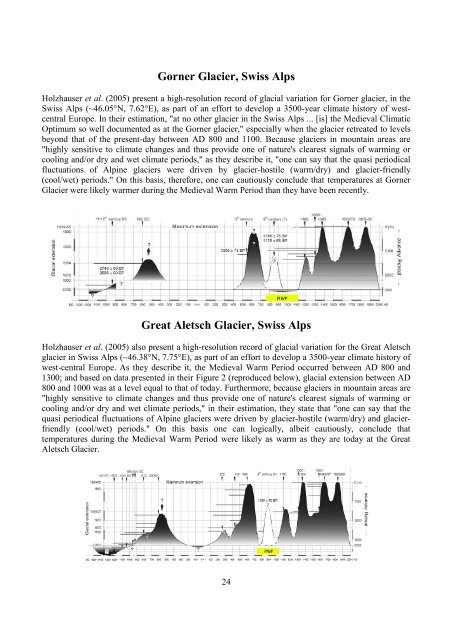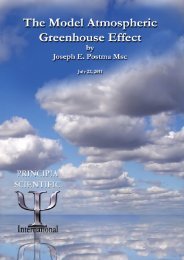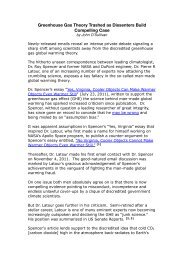Hockey Stick? What Hockey Stick? - WEBCommentary
Hockey Stick? What Hockey Stick? - WEBCommentary
Hockey Stick? What Hockey Stick? - WEBCommentary
You also want an ePaper? Increase the reach of your titles
YUMPU automatically turns print PDFs into web optimized ePapers that Google loves.
Gorner Glacier, Swiss Alps<br />
Holzhauser et al. (2005) present a high-resolution record of glacial variation for Gorner glacier, in the<br />
Swiss Alps (~46.05°N, 7.62°E), as part of an effort to develop a 3500-year climate history of westcentral<br />
Europe. In their estimation, "at no other glacier in the Swiss Alps ... [is] the Medieval Climatic<br />
Optimum so well documented as at the Gorner glacier," especially when the glacier retreated to levels<br />
beyond that of the present-day between AD 800 and 1100. Because glaciers in mountain areas are<br />
"highly sensitive to climate changes and thus provide one of nature's clearest signals of warming or<br />
cooling and/or dry and wet climate periods," as they describe it, "one can say that the quasi periodical<br />
fluctuations of Alpine glaciers were driven by glacier-hostile (warm/dry) and glacier-friendly<br />
(cool/wet) periods." On this basis, therefore, one can cautiously conclude that temperatures at Gorner<br />
Glacier were likely warmer during the Medieval Warm Period than they have been recently.<br />
Great Aletsch Glacier, Swiss Alps<br />
Holzhauser et al. (2005) also present a high-resolution record of glacial variation for the Great Aletsch<br />
glacier in Swiss Alps (~46.38°N, 7.75°E), as part of an effort to develop a 3500-year climate history of<br />
west-central Europe. As they describe it, the Medieval Warm Period occurred between AD 800 and<br />
1300; and based on data presented in their Figure 2 (reproduced below), glacial extension between AD<br />
800 and 1000 was at a level equal to that of today. Furthermore, because glaciers in mountain areas are<br />
"highly sensitive to climate changes and thus provide one of nature's clearest signals of warming or<br />
cooling and/or dry and wet climate periods," in their estimation, they state that "one can say that the<br />
quasi periodical fluctuations of Alpine glaciers were driven by glacier-hostile (warm/dry) and glacierfriendly<br />
(cool/wet) periods." On this basis one can logically, albeit cautiously, conclude that<br />
temperatures during the Medieval Warm Period were likely as warm as they are today at the Great<br />
Aletsch Glacier.<br />
24





